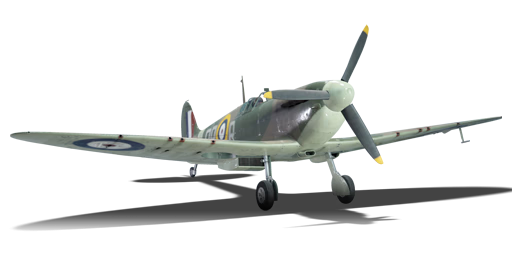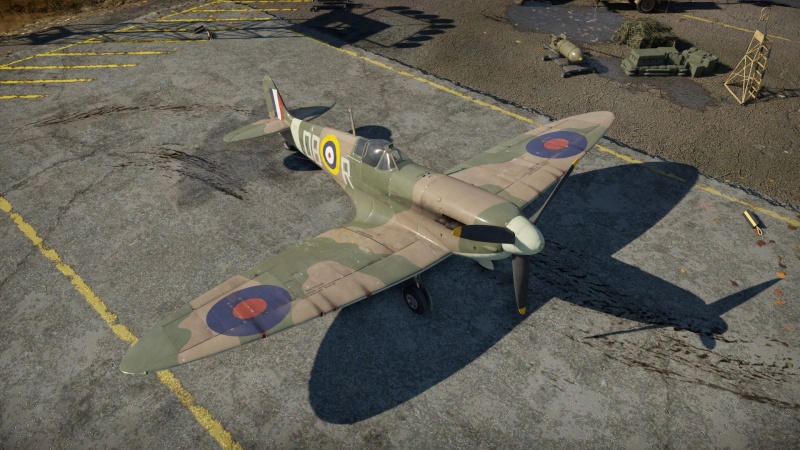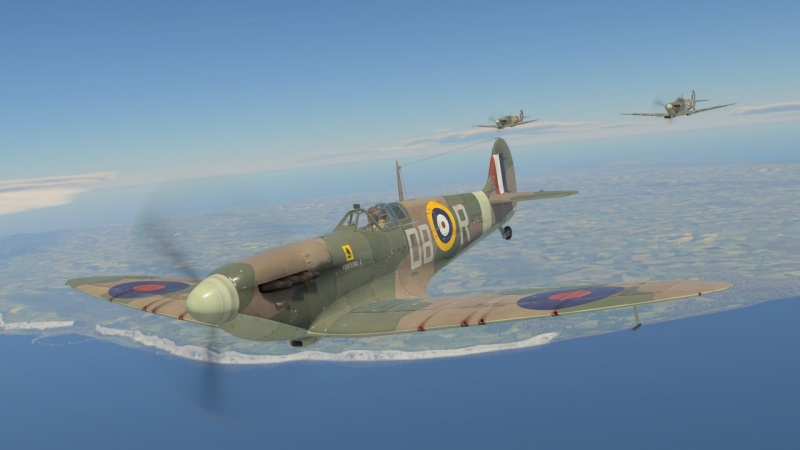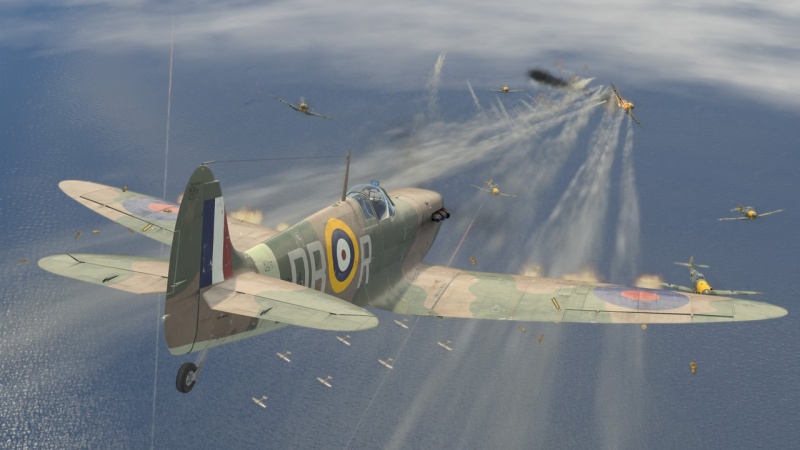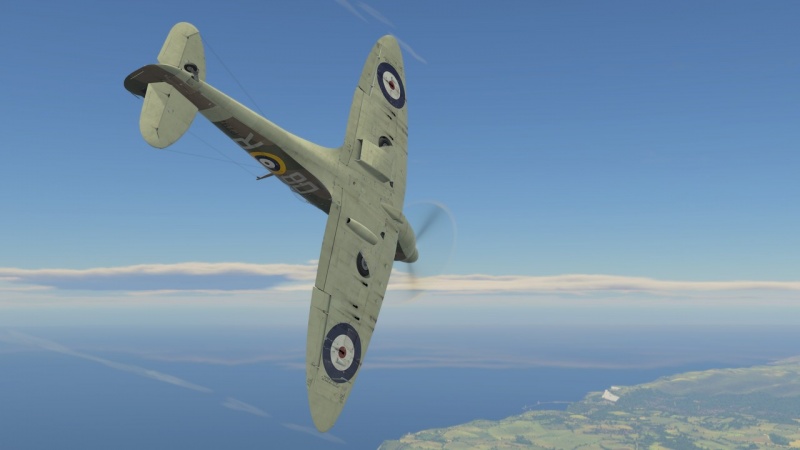Difference between revisions of "Spitfire Mk.IIa Venture I"
Toxicwaste23 (talk | contribs) (→Usage in battles) (Tag: Visual edit) |
(→Description: Updated to new standard) |
||
| (3 intermediate revisions by 2 users not shown) | |||
| Line 12: | Line 12: | ||
== Description == | == Description == | ||
<!-- ''In the description, the first part should be about the history of and the creation and combat usage of the aircraft, as well as its key features. In the second part, tell the reader about the aircraft in the game. Insert a screenshot of the vehicle, so that if the novice player does not remember the vehicle by name, he will immediately understand what kind of vehicle the article is talking about.'' --> | <!-- ''In the description, the first part should be about the history of and the creation and combat usage of the aircraft, as well as its key features. In the second part, tell the reader about the aircraft in the game. Insert a screenshot of the vehicle, so that if the novice player does not remember the vehicle by name, he will immediately understand what kind of vehicle the article is talking about.'' --> | ||
| − | + | As a method to raise funds for the war effort, a scheme was created that allowed individuals, businesses, and communities to pay to have an aircraft inscribed with a particular name (known as the "Spitfire Fund"). These special aircraft would later become known as "Presentation Spitfires". One such Spitfire (P7923) was dubbed "Venture I". Built in Castle Bromwich Aircraft Factory as a [[Spitfire Mk IIa|Mk IIa]] (thus equipped with a Merlin XII engine and 8 Browning machine guns) and entered into service on 1st February 1941, the aircraft was initially attached to the RAuxAF 610 Squadron (encoded "DW-H"), before being transferred to the RCAF 411 Squadron (encoded "DB-R"), based at RAF Digby, in July of the same year. In November 1942, the aircraft was sent to the Central Gunnery School at RAF Sutton Bridge, where it later collided with a stationary Miles Master trainer during taxi in February 1944 and was finally written off on 9th November 1944. | |
| + | |||
| + | Introduced in [[Update "Starfighters"]], the Spitfire Mk IIa Venture I plays much like its [[Spitfire Mk IIa|tech tree counterpart]]. It has excellent climb rate and is relatively fast, but its main strength is the extremely tight turn radius. This allows the pilot to confidently draw any opponent into a turning engagement and emerge victorious (bar the occasional biplane and Japanese fighters, against which the superior speed and energy characteristics of the aircraft can be utilised). However, the key drawback of the Spitfire Mk Ia is the mediocre armament. While the 8 Browning machine guns present great volume of fire, they are rather weak and quite limited by convergence due to their spread-out nature across the wings, and thus may require a long time on target to successfully down an opponent. | ||
== General info == | == General info == | ||
| Line 106: | Line 108: | ||
* 8 x 7.7 mm Browning machine guns, wing-mounted (350 rpg = 2,800 total) | * 8 x 7.7 mm Browning machine guns, wing-mounted (350 rpg = 2,800 total) | ||
| − | |||
The Spitfire has a relatively good ammo count but the 4-digit ammo can be deceiving, since there are 8 guns on the aircraft. These should be primarily used against aircraft but can also be used as last resort to attack light or non-armoured ground targets, usually with stealth or universal belts. The job should be left to dedicated gun platforms like the Hurricanes and the Hellcats. | The Spitfire has a relatively good ammo count but the 4-digit ammo can be deceiving, since there are 8 guns on the aircraft. These should be primarily used against aircraft but can also be used as last resort to attack light or non-armoured ground targets, usually with stealth or universal belts. The job should be left to dedicated gun platforms like the Hurricanes and the Hellcats. | ||
| Line 113: | Line 114: | ||
;Combat tactics | ;Combat tactics | ||
| + | The Spitfire Mk.IIa Venture I is an excellent low to medium altitude dogfighter. Lacking a supercharger, it shouldn't be used at high altitudes. In Air RB, it's best to climb to around 3,500-4,000 m (11,500-13,200 ft) where the Merlin XII engine performs optimally. After climbing, release WEP and reduce throttle to below 95% to cool the engine until you've found a target. When engaging opponents, diving should be carefully executed to avoid speeds of 450 km/h (280 mph) or greater, where control surfaces begin to suddenly stiffen. In combat, the light airframe and powerful engine provides a respectable rate of climb and an incredibly tight turning circle, combined with its eight browning machine guns, it is capable of eliminating enemy targets in short, controlled bursts. Poor weapon management will deplete your 2,800 rounds of ammunition quickly because individually, the machine guns are not very powerful. Concentrate and aim for the engine, cockpit or wings where your bullets will be most efficient at destroying vital components, such as wing spars or control surfaces. | ||
| − | + | Defensively, it's most susceptible to experienced Bf 109 pilots who know not to engage early model Spitfires in turning engagements. When forced in an energy fight or outnumbered, reduce the altitude of your opponents and fly towards your team. Use your roll rate and tight turning radius to avoid enemy fire whenever possible. The plane is capable shaking enemy fire due to its nimbleness. If no teammates are around, force the enemy to be low and slow, use your superior turn and roll-rate with flaps to get the edge. This includes against Japanese aircraft. Zeroes are the only contemporary capable of turning with this Spitfire, use your flaps and manage your engine throttle carefully, rolling scissors is an excellent manoeuvre to get the edge against light Japanese fighters. | |
| − | + | Landing the Spitfire Mk.IIa Venture I is easy, the plane doesn't like to give up speed easily, so roll 90 degrees left and right banking low and hard to reduce speed. Once around 200 km/h (125 mph), deploy your landing gear to perform a fast landing. Flaps are unnecessary unless making an emergency landing. | |
| − | |||
| − | Landing the Spitfire Mk.IIa Venture I is easy, the plane doesn't like to give up speed easily, so roll 90 degrees left and right banking low and hard to reduce speed. Once around 200 | ||
;Enemies worth noting | ;Enemies worth noting | ||
| − | |||
* Zeroes: They can outmanoeuvre the Spitfire in a turnfight. | * Zeroes: They can outmanoeuvre the Spitfire in a turnfight. | ||
* Bf 109: They can inflict tremendous damage if you don't watch out. They have quite good turning performance and their energy retention exceeds that of the Spitfire. | * Bf 109: They can inflict tremendous damage if you don't watch out. They have quite good turning performance and their energy retention exceeds that of the Spitfire. | ||
| Line 168: | Line 167: | ||
== History == | == History == | ||
| − | + | <!-- ''Describe the history of the creation and combat usage of the aircraft in more detail than in the introduction. If the historical reference turns out to be too long, take it to a separate article, taking a link to the article about the vehicle and adding a block "/History" (example: <nowiki>https://wiki.warthunder.com/(Vehicle-name)/History</nowiki>) and add a link to it here using the <code>main</code> template. Be sure to reference text and sources by using <code><nowiki><ref></ref></nowiki></code>, as well as adding them at the end of the article with <code><nowiki><references /></nowiki></code>. This section may also include the vehicle's dev blog entry (if applicable) and the in-game encyclopedia description (under <code><nowiki>=== In-game description ===</nowiki></code>, also if applicable).'' --> | |
| − | |||
| − | |||
| − | |||
| − | |||
| − | + | {{break}} | |
| − | + | {{Navigation-Start|{{Annotation|Archive of the in-game description|An archive of the historical description of the vehicle that was presented in-game prior to Update 1.55 'Royal Armour'}}|expand=true}} | |
| − | + | {{Navigation-First-Simple-Line}} | |
| − | |||
| − | |||
The Supermarine Spitfire was a British fighter which served with various nations from the late 1930s up into the 1950s. It was a single-engine, all-metal, low-wing monoplane with retractable landing gear. Various modifications served as fighters, interceptors, high-altitude fighters, fighter-bombers and reconnaissance aircraft. A total of some 20,300 Spitfires of all types were built during the war, including two-seater trainers. | The Supermarine Spitfire was a British fighter which served with various nations from the late 1930s up into the 1950s. It was a single-engine, all-metal, low-wing monoplane with retractable landing gear. Various modifications served as fighters, interceptors, high-altitude fighters, fighter-bombers and reconnaissance aircraft. A total of some 20,300 Spitfires of all types were built during the war, including two-seater trainers. | ||
| − | In the summer of 1939, an early Spitfire Mk I was fitted with the new Rolls Royce Merlin XII engine, which had a higher output of 1175 HP and was fitted with a Coffman engine starter instead of the previous Merlin's electrical starter system. This, combined with the Rotol variable pitch propeller which had been used on many Spitfire Mk Is would now form the powerplant of the new Spitfire Mk II, although some production models used the De Havilland propeller. The Mk II was some 6-7 mph faster than the later Spitfire Mk I, but still slower than the original Spitfires before a series of modifications increased the aircraft's weight. As with the Mk I, the Spitfire Mk II was produced with either eight machine guns as the Spitfire Mk IIA, or two | + | In the summer of 1939, an early Spitfire Mk I was fitted with the new Rolls Royce Merlin XII engine, which had a higher output of 1175 HP and was fitted with a Coffman engine starter instead of the previous Merlin's electrical starter system. This, combined with the Rotol variable pitch propeller which had been used on many Spitfire Mk Is would now form the powerplant of the new Spitfire Mk II, although some production models used the De Havilland propeller. The Mk II was some 6-7 mph faster than the later Spitfire Mk I, but still slower than the original Spitfires before a series of modifications increased the aircraft's weight. As with the Mk I, the Spitfire Mk II was produced with either eight machine guns as the Spitfire Mk IIA, or two 20 mm cannon and four machine guns as the Mk IIb. The earlier problems with cannon fitted to the Mk IB had now been solved by introducing a belt feed system to the weapon to replace the earlier drum, turning the cannon on its side and fitting a blister on the wing to house the new mechanism. |
920 Spitfire Mk IIs entered service; 750 Mk IIA and 170 MK IIB, although fighters used in the air-sea rescue role were later designated Mk IIC. The Spitfire II quickly replaced the Spitfire I, with the older variant being relegated to use in Operational Training Units. By April 1941, RAF Fighter Command had completed re-equipping with the Mk II, although this too would soon be replaced by the Mk V. | 920 Spitfire Mk IIs entered service; 750 Mk IIA and 170 MK IIB, although fighters used in the air-sea rescue role were later designated Mk IIC. The Spitfire II quickly replaced the Spitfire I, with the older variant being relegated to use in Operational Training Units. By April 1941, RAF Fighter Command had completed re-equipping with the Mk II, although this too would soon be replaced by the Mk V. | ||
| + | {{Navigation-End}} | ||
== Media == | == Media == | ||
| Line 189: | Line 183: | ||
;Skins | ;Skins | ||
| − | + | * [https://live.warthunder.com/feed/camouflages/?vehicle=spitfiremkiia_ep Skins and camouflages for the {{PAGENAME}} from live.warthunder.com.] | |
| − | * [https://live.warthunder.com/feed/camouflages/? | ||
;Videos | ;Videos | ||
| Line 201: | Line 194: | ||
;Related development | ;Related development | ||
| − | |||
* [[Spitfire (Family)]] | * [[Spitfire (Family)]] | ||
| Line 207: | Line 199: | ||
<!-- ''Paste links to sources and external resources, such as:'' | <!-- ''Paste links to sources and external resources, such as:'' | ||
* ''topic on the official game forum;'' | * ''topic on the official game forum;'' | ||
| − | |||
* ''other literature.'' --> | * ''other literature.'' --> | ||
Latest revision as of 17:33, 23 July 2023
| This page is about the premium British fighter Spitfire Mk.IIa Venture I. For other versions, see Spitfire (Family). |
Contents
Description
As a method to raise funds for the war effort, a scheme was created that allowed individuals, businesses, and communities to pay to have an aircraft inscribed with a particular name (known as the "Spitfire Fund"). These special aircraft would later become known as "Presentation Spitfires". One such Spitfire (P7923) was dubbed "Venture I". Built in Castle Bromwich Aircraft Factory as a Mk IIa (thus equipped with a Merlin XII engine and 8 Browning machine guns) and entered into service on 1st February 1941, the aircraft was initially attached to the RAuxAF 610 Squadron (encoded "DW-H"), before being transferred to the RCAF 411 Squadron (encoded "DB-R"), based at RAF Digby, in July of the same year. In November 1942, the aircraft was sent to the Central Gunnery School at RAF Sutton Bridge, where it later collided with a stationary Miles Master trainer during taxi in February 1944 and was finally written off on 9th November 1944.
Introduced in Update "Starfighters", the Spitfire Mk IIa Venture I plays much like its tech tree counterpart. It has excellent climb rate and is relatively fast, but its main strength is the extremely tight turn radius. This allows the pilot to confidently draw any opponent into a turning engagement and emerge victorious (bar the occasional biplane and Japanese fighters, against which the superior speed and energy characteristics of the aircraft can be utilised). However, the key drawback of the Spitfire Mk Ia is the mediocre armament. While the 8 Browning machine guns present great volume of fire, they are rather weak and quite limited by convergence due to their spread-out nature across the wings, and thus may require a long time on target to successfully down an opponent.
General info
Flight performance
| Characteristics | Max Speed (km/h at 4,572 m) |
Max altitude (metres) |
Turn time (seconds) |
Rate of climb (metres/second) |
Take-off run (metres) | |||
|---|---|---|---|---|---|---|---|---|
| AB | RB | AB | RB | AB | RB | |||
| Stock | 545 | 535 | 10000 | 16.1 | 16.5 | 14.0 | 16.0 | 300 |
| Upgraded | 599 | 571 | 14.8 | 15.1 | 27.3 | 19.4 | ||
Details
| Features | ||||
|---|---|---|---|---|
| Combat flaps | Take-off flaps | Landing flaps | Air brakes | Arrestor gear |
| X | X | ✓ | X | X |
| Limits | ||||||
|---|---|---|---|---|---|---|
| Wings (km/h) | Gear (km/h) | Flaps (km/h) | Max Static G | |||
| Combat | Take-off | Landing | + | - | ||
| 760 | 270 | N/A | N/A | 230 | ~11 | ~6 |
| Optimal velocities (km/h) | |||
|---|---|---|---|
| Ailerons | Rudder | Elevators | Radiator |
| < 321 | < 400 | < 350 | > 500 |
| Compressor | Optimal altitude | 100% Engine power | WEP Engine power |
|---|---|---|---|
| Setting 1 | 4,490 m | 1,140 hp | 1,311 hp |
Survivability and armour
- 38 mm Bulletproof glass in cockpit front.
- 4 mm Steel plate in pilot's seat.
- 6-7 mm Steel plate behind the pilot.
Modifications and economy
Armaments
Offensive armament
The Spitfire Mk.IIa Venture I is armed with:
- 8 x 7.7 mm Browning machine guns, wing-mounted (350 rpg = 2,800 total)
The Spitfire has a relatively good ammo count but the 4-digit ammo can be deceiving, since there are 8 guns on the aircraft. These should be primarily used against aircraft but can also be used as last resort to attack light or non-armoured ground targets, usually with stealth or universal belts. The job should be left to dedicated gun platforms like the Hurricanes and the Hellcats.
Usage in battles
- Combat tactics
The Spitfire Mk.IIa Venture I is an excellent low to medium altitude dogfighter. Lacking a supercharger, it shouldn't be used at high altitudes. In Air RB, it's best to climb to around 3,500-4,000 m (11,500-13,200 ft) where the Merlin XII engine performs optimally. After climbing, release WEP and reduce throttle to below 95% to cool the engine until you've found a target. When engaging opponents, diving should be carefully executed to avoid speeds of 450 km/h (280 mph) or greater, where control surfaces begin to suddenly stiffen. In combat, the light airframe and powerful engine provides a respectable rate of climb and an incredibly tight turning circle, combined with its eight browning machine guns, it is capable of eliminating enemy targets in short, controlled bursts. Poor weapon management will deplete your 2,800 rounds of ammunition quickly because individually, the machine guns are not very powerful. Concentrate and aim for the engine, cockpit or wings where your bullets will be most efficient at destroying vital components, such as wing spars or control surfaces.
Defensively, it's most susceptible to experienced Bf 109 pilots who know not to engage early model Spitfires in turning engagements. When forced in an energy fight or outnumbered, reduce the altitude of your opponents and fly towards your team. Use your roll rate and tight turning radius to avoid enemy fire whenever possible. The plane is capable shaking enemy fire due to its nimbleness. If no teammates are around, force the enemy to be low and slow, use your superior turn and roll-rate with flaps to get the edge. This includes against Japanese aircraft. Zeroes are the only contemporary capable of turning with this Spitfire, use your flaps and manage your engine throttle carefully, rolling scissors is an excellent manoeuvre to get the edge against light Japanese fighters.
Landing the Spitfire Mk.IIa Venture I is easy, the plane doesn't like to give up speed easily, so roll 90 degrees left and right banking low and hard to reduce speed. Once around 200 km/h (125 mph), deploy your landing gear to perform a fast landing. Flaps are unnecessary unless making an emergency landing.
- Enemies worth noting
- Zeroes: They can outmanoeuvre the Spitfire in a turnfight.
- Bf 109: They can inflict tremendous damage if you don't watch out. They have quite good turning performance and their energy retention exceeds that of the Spitfire.
- Heavy Bombers: Although the Spitfire Mk IIa is armed with 8 guns, they are only 7.7 mm in calibre. So, it can be difficult to destroy heavy fighters, attackers, and especially bombers. It is likely that long bursts will be necessary to destroy such targets, and that gives time for enemy turret gunners to shoot back. Luckily, most bombers at this tier are not defended by turrets from all angles. Try to plan attack runs so that you don't fly in the enemy's line of fire.
Manual Engine Control
| MEC elements | ||||||
|---|---|---|---|---|---|---|
| Mixer | Pitch | Radiator | Supercharger | Turbocharger | ||
| Oil | Water | Type | ||||
| Controllable | Controllable Not auto controlled |
Not controllable Not auto controlled |
Controllable Not auto controlled |
Separate | Not controllable 1 gear |
Not controllable |
Pros and cons
Pros:
- Eight 7.7 mm machine guns provide great anti-fighter power
- Great turn rate
- Good roll rate at low speed
- Better-than-average top speed
- Great rate of climb
- Better engine power than Spitfire Mk Ia
- Decent amount of armour, a front 38 mm glass and rear 4-7 mm steel plates
Cons:
- Machine guns only effective if the target is hit in continuous bursts
- Machine gun armament lacks the long range hitting power of cannons
- Ammo can run out quickly in prolonged, uncontrolled bursts
- Quick kills against large bombers without a pilot snipe is difficult, prolonged engagements expose the Spitfire to the defensive gunners
- Machine guns cannot penetrate heavily armoured targets
- Bad high altitude performance
- Roll rate stiffens dramatically at ~350 km/h
- Pulling negative G's and rolling the plane (Realistic/simulator only) can cause the carburettor (engine) to fail
History
| Archive of the in-game description | |
|---|---|
|
The Supermarine Spitfire was a British fighter which served with various nations from the late 1930s up into the 1950s. It was a single-engine, all-metal, low-wing monoplane with retractable landing gear. Various modifications served as fighters, interceptors, high-altitude fighters, fighter-bombers and reconnaissance aircraft. A total of some 20,300 Spitfires of all types were built during the war, including two-seater trainers. In the summer of 1939, an early Spitfire Mk I was fitted with the new Rolls Royce Merlin XII engine, which had a higher output of 1175 HP and was fitted with a Coffman engine starter instead of the previous Merlin's electrical starter system. This, combined with the Rotol variable pitch propeller which had been used on many Spitfire Mk Is would now form the powerplant of the new Spitfire Mk II, although some production models used the De Havilland propeller. The Mk II was some 6-7 mph faster than the later Spitfire Mk I, but still slower than the original Spitfires before a series of modifications increased the aircraft's weight. As with the Mk I, the Spitfire Mk II was produced with either eight machine guns as the Spitfire Mk IIA, or two 20 mm cannon and four machine guns as the Mk IIb. The earlier problems with cannon fitted to the Mk IB had now been solved by introducing a belt feed system to the weapon to replace the earlier drum, turning the cannon on its side and fitting a blister on the wing to house the new mechanism. 920 Spitfire Mk IIs entered service; 750 Mk IIA and 170 MK IIB, although fighters used in the air-sea rescue role were later designated Mk IIC. The Spitfire II quickly replaced the Spitfire I, with the older variant being relegated to use in Operational Training Units. By April 1941, RAF Fighter Command had completed re-equipping with the Mk II, although this too would soon be replaced by the Mk V. | |
Media
- Skins
- Videos
See also
- Related development
External links
| Supermarine | |
|---|---|
| Spitfires | |
| Merlin engine | Spitfire Mk Ia · Spitfire Mk IIa · Spitfire Mk.IIa Venture I · Spitfire Mk IIb |
| Spitfire Mk Vb · Spitfire Mk Vb/trop · Spitfire Mk Vc · Spitfire Mk Vc/trop | |
| Spitfire F Mk IX · Spitfire F Mk IXc · Spitfire F Mk XVI | |
| Spitfire LF Mk IX · Plagis' Spitfire LF Mk IXc | |
| Griffon engine | Spitfire F Mk XIVc · Spitfire F Mk XIVe · Prendergast's Spitfire FR Mk XIVe · Spitfire F Mk XVIIIe · Spitfire F Mk 22 · Spitfire F Mk 24 |
| Export | ▄Spitfire Mk Vb/trop · ▃Spitfire LF Mk IXc · ▂Spitfire Mk IXc · Spitfire Mk IXc · Spitfire Mk.IX (CW) · Weizman's Spitfire LF Mk.IXe · ▄Spitfire FR Mk XIVe |
| Seafires | Seafire LF Mk.III · Seafire F Mk XVII · Seafire FR 47 |
| Export | ▄Seafire LF Mk.III |
| Jet fighters | Attacker FB 1 · Attacker FB.2 · Scimitar F Mk.1 · Swift F.1 · Swift F.7 |
| Hydroplanes | Walrus Mk.I |
| Britain premium aircraft | |
|---|---|
| Fighters | Tuck's Gladiator Mk II · ▄Boomerang Mk I · ▄Boomerang Mk II · ▄D.520 |
| ▄Martlet Mk IV · ▄Corsair F Mk II · ▄Hellcat Mk II · ▄Thunderbolt Mk.1 · ▄Mustang Mk IA | |
| Hurricane Mk.I/L FAA M · Spitfire Mk.IIa Venture I · Spitfire F Mk IXc · Plagis' Spitfire LF Mk IXc · Spitfire F Mk XIVc · Prendergast's Spitfire FR Mk XIVe | |
| Typhoon Mk Ib · MB.5 | |
| Twin-engine fighters | Hornet Mk.I · Whirlwind P.9 |
| Jet fighters | Attacker FB.2 · Hunter FGA.9 · Lightning F.53 · Meteor F Mk.8 Reaper · Sea Vixen F.A.W. Mk.2 · F-4J(UK) Phantom II · ▄MiG-21 Bison |
| Strike aircraft | ▄Wirraway · Beaufighter Mk I (40-mm) · Wyvern S4 |
| Harrier GR.1 · Strikemaster Mk.88 | |
| Bombers | ▄Avenger Mk II · ▄Boston Mk I · ▄Catalina Mk IIIa · ▄DB-7 · ▄Havoc Mk I · ▄Hudson Mk V · Swordfish Mk II |


